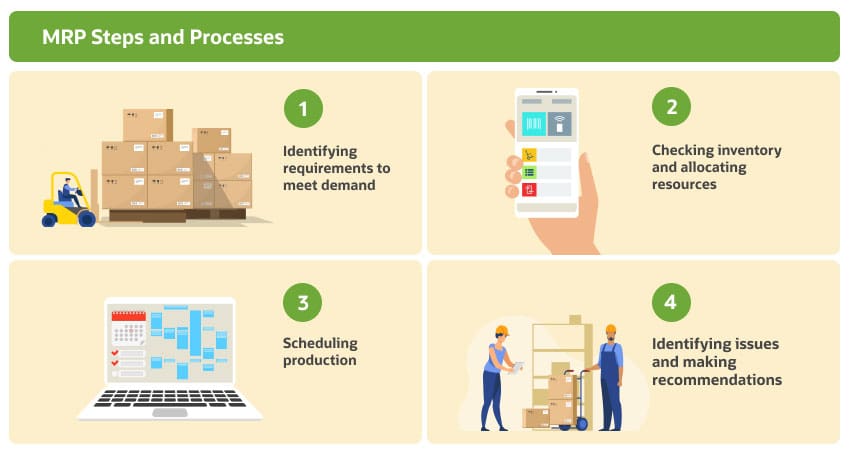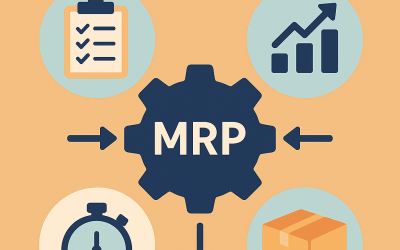How MRP Works
A Material Requirements Planning (MRP) system accelerates the manufacturing production process by determining what raw materials, components and subassemblies are needed, and when to assemble the finished goods, based on demand and bill of materials (BOM). It does this by asking three main questions:
- What is needed?
- How much is needed?
- When is it needed by?
The answers to these questions provide clarity into what materials are needed, how many and when to fulfill the required demand and help facilitate an efficient and effective production schedule.
Why Is MRP important?
MRP gives businesses visibility into the inventory requirements needed to meet demand, helping your business optimize inventory levels and production schedules. Without this insight, companies have limited visibility and responsiveness, which can lead to:
- Ordering too much inventory, which increases carrying costs and ties up more cash in inventory overhead that could be used elsewhere.
- Inability to meet demand because of insufficient raw materials, resulting in lost sales, canceled contracts and out-of-stocks.
- Disruptions in the production cycle, delaying sub-assembly builds that result in increased production costs and decreased output.
Manufacturing companies rely heavily on MRP as the supply planning system to plan and control inventory, scheduling and production, but MRP is also relevant in many other industries, from retail to restaurants, to create balance between supply and demand.
Your Complete Guide to Inventory Forecasting
MRP Steps and Processes
The MRP process can be broken down into four major steps:
1. Identifying requirements to meet demand.
The first step of the MRP process is identifying customer demand and the requirements needed to meet it, which starts with inputting customer orders and sales forecasts.
Using the bill of materials required for production, MRP then disassembles demand into the individual components and raw materials needed to complete the build while accounting for any required sub-assemblies.
2. Checking inventory and allocating resources.
Utilizing the MRP to check demand against inventory and allocating resources accordingly, you can see both what items you have in stock and where they are—this is especially important if you have inventory across several locations. This also lets you see the status of items, which gives visibility into items that are already allocated to another build, as well as items not yet physically in the warehouse that are in transit, or on order. The MRP then moves inventory into the proper locations and prompts reorder recommendations.
3. Scheduling production.
Using the master production schedule, the system determines how much time and labor are required to complete each step of each build and when they need to happen so that the production can occur without delay. The production schedule also identifies what machinery and workstations are needed for each step and generates the appropriate work orders, purchase orders and transfer orders. If the build requires subassemblies, the system takes into account how much time each subassembly takes and schedules them accordingly.
4. Identifying issues and making recommendations.
Finally, because the MRP links raw materials to work orders and customer orders, it can automatically alert your team when items are delayed and make recommendations for existing orders: automatically moving production in or out, performing what-if analyses, and generating exception plans to complete the required builds.

MRP steps include identifying requirements, checking inventory, scheduling production, and identifying issues.
MRP Inputs
How well your MRP system works depends on the quality of the data you provide it. For an MRP system to work efficiently, each input must be accurate and updated. Here are some of the inputs an MRP depends on:
-
Demand
Including sales forecasts and customer orders. When working with predicted demand, a system that is integrated with an enterprise-wide ERP system allows forecasting using historical sales vs. just sales forecasts.
-
Bill of materials (BOM)
Keeping a single updated version of the bill of materials is essential for accurate supply forecasting and planning. A system that’s integrated into the enterprise-wide inventory management system avoids version control issues and building against outdated bills, which results in reworks and increased waste.
-
Inventory
It’s essential to have a real-time view of inventory across the organization to understand what items you have on hand and which are en route or have purchase orders issued, where that inventory is and what the inventory’s status is.
-
Master production schedule
The master production schedule takes all build requirements and plans machinery usage, labor and workstations to account for all outstanding work orders to be completed.
MRP Outputs
Using the provided inputs, the MRP calculates what materials are needed, how much is needed to complete the build and when in the build process they are needed.
With this information defined, businesses can execute on just-in-time (JIT) production, scheduling production based on material availability. This minimizes inventory levels and carrying costs, as inventory is not stored in the warehouse for future production but arrives as needed. By scheduling materials to arrive and production to begin soon after, businesses can move materials through the workflow process without delay.
The MRP lays out the plan of when materials should arrive, based on when they’re needed in the production process, and when subassemblies should be scheduled. Using a master production plan and taking into account subassembly build times minimizes materials sitting on shelves and bottlenecks in the build process.
Benefits of MRP
MRP systems allow you to plan and schedule production efficiently, making sure materials move through the work order quickly and helping businesses fulfill customer orders on time.
An MRP system that is integrated across an organization eliminates manual processes, such as pulling historical sales and existing inventory. You spend less time building Gantt charts and production flows to understand when and where you need product available, which frees up time and removes a layer of complexity.
When builds are complex and require multiple sub-assemblies within the work order, it’s easy to miscalculate timing. An MRP helps you understand all of the components that go into each sub-assembly and how long it takes to complete each step, preventing delays in the production cycle and increasing production yield.
MRP Challenges
Although using an MRP solution is a far better than using spreadsheets for supply planning, it’s only as good as the data you put into it. The better a business understands and documents its processes, the better an MRP system can serve them.
You need to make sure you input correct inventory availability, time to complete a subassembly, waste calculations and lead-times from vendors. Otherwise, your production schedule will be inaccurate—an MRP can’t define the production build timeline and materials required if the data isn’t accounted for in the inventory record, bill of materials and master production schedule
MRP vs. ERP
MRP systems focus specifically on planning and controlling how goods are assembled using multiple raw materials or components by controlling inventory, componentry and the manufacturing process.
Enterprise resource planning (ERP) systems are an offshoot of MRP systems, spurred by businesses finding a need for the same level of planning and oversight for other operations such as payroll, finances and supplier management. ERP systems plan for resources across the entire organization, including: financial management, order management, customer relationship management, people, procurement, warehousing and fulfillment.
Article Provided By: netsutie
 TSVMap is here to help grow your manufacturing processes and consult on your IT Solutions, that way we can make it more effective and efficient. So if you need: IT Solutions, Consultants, ERP Systems, MRP Systems, Automations, or Cyber Security. Contact us today at 864-991-5656 or Email info@tsvmap.com
TSVMap is here to help grow your manufacturing processes and consult on your IT Solutions, that way we can make it more effective and efficient. So if you need: IT Solutions, Consultants, ERP Systems, MRP Systems, Automations, or Cyber Security. Contact us today at 864-991-5656 or Email info@tsvmap.com









0 Comments